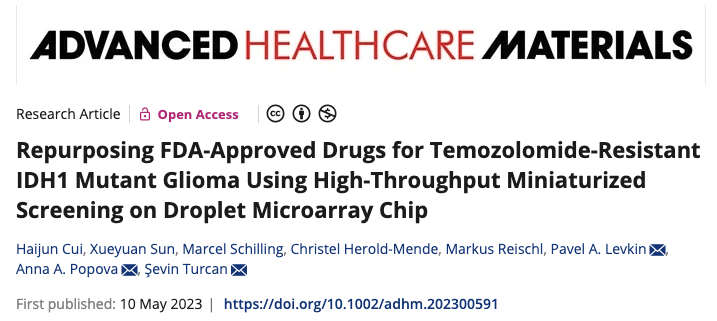In the paper Repurposing FDA-Approved Drugs for Temozolomide-Resistant IDH1 Mutant Glioma Using High-Throughput Miniaturized Screening on Droplet Microarray Chip published to Advanced Healthcare Materials (Fig. 1), researchers from the Institute of Biological and Chemical Systems – Functional Molecular Systems (IBCS-FMS) of Karlsruhe Institute of Technology (KIT) and Key Laboratory of Biorheological Science and Technology from the College of Bioengineering at Chongqing University conducted a high-throughput screening of FDA-approved drugs to identify potential treatments for recurrent gliomas with IDH1 mutations.
They found that verteporfin (VP) effectively inhibited tumor growth and viability in patient-derived tumorspheres. Proteomics analysis suggests that VP targets the nuclear pore complex, a novel mechanism of action independent of its known effects on YAP1.

Figure 1. "Repurposing FDA-Approved Drugs for Temozolomide-Resistant IDH1 Mutant Glioma Using High-Throughput Miniaturized Screening on Droplet Microarray Chip" in the publication Advanced Healthcare Materials.
Further analysis revealed that high expression of NUP107, a potential upstream regulator of VP response, is associated with decreased survival in IDH1mut astrocytoma. This study demonstrates a cost-effective drug repurposing approach using 3D glioma models and identifies nuclear pore complex as a promising target for drug development.
The findings provide preclinical evidence supporting further investigation of VP and other identified compounds for treating IDH1mut gliomas and potentially improving clinical outcomes for patients with this challenging disease.
Preparation of 3D Glioma Spheroid Array
Cui, H., Sun, X., et al. used droplet microarray (DMA) slides to test different drugs on cancer cells. The DMA has tiny spots that are coated with a substance that prevents the cells from sticking to them. The researchers placed 200 nL of cell suspension (cell concentration, 1.5 × 106 mL−1) in each spot using the automated liquid dispensing benefits of the I.DOT Non-Contact Dispenser, and then tested different drugs to see which ones killed the cells. (Fig. 2)
 Figure 2. Cui, H., Sun, X., Schilling, M. et al.'s (2023) 3D glioma spheroid array preparation workflow, which included droplet microarray (DMA) slides (Aquarray GmbH), Accutase (BioLegend, Inc.), the I.DOT Liquid Handler (DISPENDIX), an incubator, and the All-in-One Fluorescence Microscope BZ-X800 (Keyence).
Figure 2. Cui, H., Sun, X., Schilling, M. et al.'s (2023) 3D glioma spheroid array preparation workflow, which included droplet microarray (DMA) slides (Aquarray GmbH), Accutase (BioLegend, Inc.), the I.DOT Liquid Handler (DISPENDIX), an incubator, and the All-in-One Fluorescence Microscope BZ-X800 (Keyence).
Cui, H., Sun, X., Schilling, M. et al. (2023) demonstrated the feasibility of building a 3D glioma spheroid model on the DMA chip for drug screening. They successfully identified over 20 FDA-approved drugs with therapeutic potential against TMZ-R IDH1mut gliomas.
We at DISPENDIX are thrilled by the I.DOT Non-Contact Dispenser's crucial role in this process, as it has the potential to provide urgently needed solutions for the clinical treatment of therapy-resistant gliomas.

Optimize Your Lab Workflow
Are you struggling to keep up with your workload? Do you feel like you're constantly bogged down by paperwork and administrative tasks? If so, you're not alone. Many scientific researchers struggle to optimize their workflow, leading to decreased efficiency and productivity.
Our team of experienced professionals at DISPENDIX will work with you to assess your current workflow and identify areas for improvement. We will then help you to develop and implement a new semi-automated workflow that is tailored to your specific needs.
Benefits of Working with DISPENDIX:
- Increased efficiency and productivity
- Reduced paperwork and administrative tasks
- Improved data quality and accuracy
- More time for research
Don't let your laborious manual workflow get in the way of your drug discovery. Contact us today to schedule a free consultation. We can help you optimize your workflow and take your research to the next level.
References
Cui, H., Sun, X., Schilling, M., Herold-Mende, C., Reischl, M., Levkin, P. A., Popova, A. A., Turcan, Ş., Repurposing FDA-Approved Drugs for Temozolomide-Resistant IDH1 Mutant Glioma Using High-Throughput Miniaturized Screening on Droplet Microarray Chip. Adv. Healthcare Mater. 2023, 12, 2300591. https://doi.org/10.1002/adhm.202300591